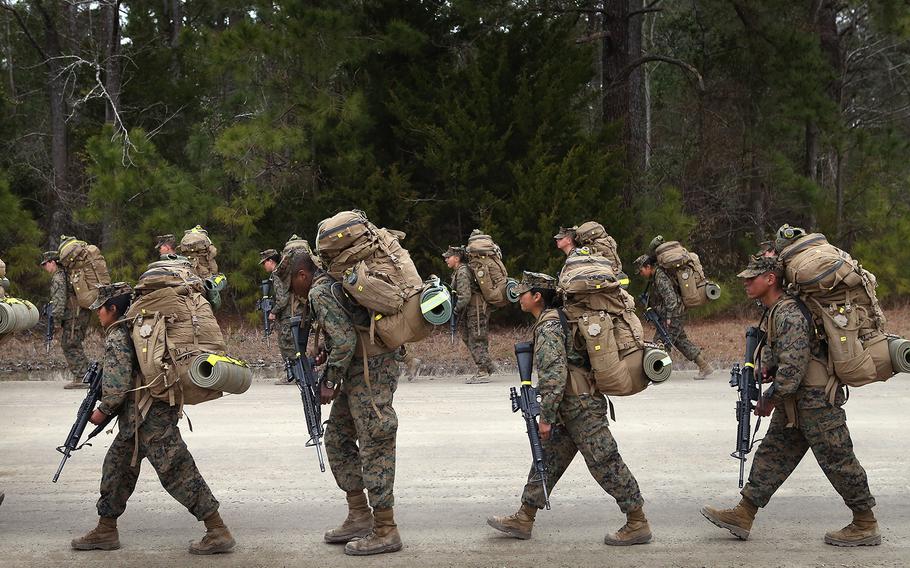
Marines participate in a 10 kilometer training march carrying 55 pound packs during Marine Combat Training (MCT) on Feb. 22, 2013, at Camp Lejeune, N.C. (Scott Olson, Getty Images/TNS)
Since the early 20th century, the U.S. military’s negligent use, storage and disposal of harmful chemical substances on its bases has exposed countless troops to severe health hazards. One example is Camp Lejeune, a Marine Corps base in North Carolina, where toxic contamination went unnoticed for several decades until measures were taken in the mid-1980s. As a result, thousands of veterans and their family members developed life-threatening and debilitating diseases.
Veterans aren’t the only people impacted by the military’s careless practices. Contaminated bases pose a public health threat to surrounding communities, which are often populated by marginalized minority groups. What’s more, service members of color face higher toxic exposure risks due to the lower ranking status they are usually relegated to.
Camp Lejeune, built during World War II, served as the first base where African American Marines were trained. During these initial years, these recruits were segregated to Point Montford, a facility located on the base’s marshy northern outskirts. When the military desegregated in the late 1940s, African American Marines were shuffled from Point Montford to other facilities across Camp Lejeune where contamination ran rampant.
From 1953 to 1987, nearly 1 million troops and their families were exposed to a cocktail of toxic hazards from on-site and off-base sources, including notorious carcinogens like per/polyfluoroalkyl substances, or PFAS, which are commonly known as “forever chemicals.” Despite its notoriety, Camp Lejeune is only one of the more than 700 bases affected by toxic contamination, with grave implications for minority service members.
Although the Department of Defense has acknowledged the extensive issues with toxic contaminants on its installations and has increasingly been addressing them, progress has been lackluster. Only nine of the 50 bases with the highest rates of PFAS contaminants currently have clean-up plans underway. Even more concerning, the Department of Defense found that PFAS from at least 12 bases are contaminating the water supplies in their vicinity and threatening surrounding communities.
In other instances, the military’s disregard for public health was far more blatant. During the Trump administration, more than 20 million pounds of toxic PFAS-containing firefighting foam were covertly burned across the country, often near impoverished minority neighborhoods.
Combating environmental racism requires comprehensive legal action that addresses environmental crime at its core. Despite Trump’s reckless mishandling of environmental policy, the United States’ long standing toxic contaminant issues are a focal point for the Biden administration, whose Justice40 program seeks to direct 40% of future climate investments toward at-risk minority communities.
In August, the Honoring Our PACT Act passed with solid bipartisan support and was signed into law, providing veterans and their families affected by toxins on bases like Camp Lejeune with easier access to improved medical benefits and compensation.
Other legal initiatives, such as the Clean Water for Military Families Act and Filthy Fifty Act, push for increased action to speed up remediation efforts on military bases affected by widespread PFAS contaminants. Most encouraging of all, the EPA recently updated its health advisory recommendations for PFAS compounds, reducing safety limits from 70 parts per trillion to a significantly lower standard that better reflects the risks these ubiquitous contaminants represent.
Jonathan Sharp serves the Environmental Litigation Group, PC, as chief financial officer. The Birmingham, Ala.-based law firm specializes in toxic exposure cases, helping individuals who were harmed by toxic substances on U.S. Army bases. This column was produced by Progressive Perspectives, which is run by The Progressive magazine and distributed by Tribune News Service.
©2022 Tribune Content Agency, LLC.